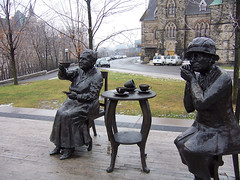Resource Scheduler and Resource Task Quantizer originally uploaded by David Seah [also check out David's websitewhere he explains his scheduler/quantizer in greater detail].  Lisbeth Calandrino
Lisbeth Calandrino - whom you may remember from an early post titled
What Consumers Really Think detailing consumer research she and
Sonna Calandrino conducted - moderated a panel discussion during
Surfaces 2007 on "
Strategies for a Successful Retailer." Participating were
Tom Jennings from Bud Jennings Carpet One,
Olga Robertson from
FCA Network and
Tom Boschwitz from Home Value/
Drexel Interiors.
Lis Calandrino, very involved with
Sonna on
Fabulous Floors Magazine, also contributes to
Floor Focus Magazine, and has an amazing training and presenting reputation in the industry. Not only has she created powerful training programs, but she also has to be the most dynamic and engaging speaker I've encountered in a long time. Unfortunately, I missed her presentation titled "
Building Your Competitive Advantage" [conflicted with my session!], but got a taste for her ability to draw in the audience while showcasing the uniqueness of her panelists in this session.
Tom Jennings went first. He is President, Bud Jennings Carpet One in Lawrence, Kansas. It's a 47 year old company, with one 5000 square foot store that generates $4m in business. Pretty impressive. Tom has also just sold the business and will be managing installation training at
CCA Global.
Read this Floor Focus
Best Practices article [by
Lis Calandrino!] about Bud Jennings Carpet One and you'll understand how extraordinary this business is. Note that Tom has a
predominantly female sales staff; installation is an integral part of the business [not an afterthought]. Pay attention to how he promotes his company [i.e., Bud Bugs], and how important he considers DETAILS [which women notice] and the messages that these DETAILS communicate. This is a company that takes the customer very seriously!
Tom Jennings focused on how critical it is to
connect the front end of the store [i.e., sales]
to the back end [i.e., installation]. I found this profound given my Mom's experience [see
My Mom Is In The Market For Carpet,
Next Issue: Dizzying Choices, and
Final Issue: Endless Frustrations].
Some of his points:
communication is critical; the best installer isn't necessarily the best with the customer. Expect good results and you will get good results. Reward positive behavior... Lots of sound management advice here!
He addressed the sales to installer relationship as well as the installer to sales relationship. No surprise, there were many overlaps. Nonetheless, I haven't often heard about such planned integration between the many steps in the flooring sales/installation process to successfully
delight the consumer!For sales: communicate constantly because no one likes surprises. Be sure to affirm the skills and abilities of the installers [i.e., know their names!]. Know what installers can and cannot do so the salesperson can prepare the customer. Remember that what the installer does today
affects the future [i.e., repeat purchases, referrals]. Be flexible. Try to solve problems rather than blame others. Be a team player. Be
excellent at passing the baton. Don't express opinions if you don't know enough. Don't give the customer the impression that you are handing them off. Reward positive behavior and don't forget the support behind the work.
For installers: communicate constantly. Affirm the abilities of sales and management. Remember that
sales today affect the installer today. Be a team player. Don't point fingers. From a training perspective, it's critical to teach installers how to approach a customer's front door; how to deal with the first 10 minutes of a customer visit. For example, arrive with only a clipboard, not with multiple bags of tools and supplies. Discuss expectations first, listen, confirm that where you have parked won't
interfere with the consumer. The analogy he used was visiting a surgeon for the first time - do you meet a person in regular clothes or one in scrubs with scalpel in hand ready to make incisions on you at that instant?
Jennings requires that his staff call ahead to say that
they will be on time! What a concept!
Next, came Olga Robertson, President
FCA Network, an exclusive buying group for 60 independent specialty flooring retailers around the US, including the affiliated
FCA Inc. stores, which she joined in 1978.
FCA has 6 full service locations in the Chicago area generating $40m in floor covering sales. Olga started
FCA Network in 1998, and has grown the network to $70m in professional installations.
She was recently named one of the 20 most influential women in the flooring industry by
Floor Covering News as described in
Flooring Group Honors Local Woman.
Robertson discussed the
changing dynamics on the sales floor and how that affects the consumer. Indeed, the biggest change is that the
internet -rather than a salesperson- is what influences a consumer's choices in floor covering. She still expects service and good value and will still buy from people she likes and trusts, but she is predisposed to buy a certain product as a result of what she sees/experiences online.
This means that salespeople training must take place on an
ongoing basis and at least weekly! For many retailers, this creates a burden as many don't know how to train, or prefer not to because they either don't know how or don't like to train. Retailers have plenty of options available: they can bring in experts like
Sam Allman to teach courses like the Secrets of Peak Performing Salespeople. Take advantage, too, of the training that manufacturer representatives can offer.
Robertson urges retailers to work closely with manufacturer reps to ensure that the training follows specific guidelines [20 minute
timeframe, be sure to address topics such as features and benefits of products, installations dos and
don'ts, what's in it for the consumer.....].
That is the only way to differentiate oneself from the Big Box retailers.
Last, but not least, was Tom
Boschwitz, COO,
Home Valu Interiors, headquartered in Minneapolis, MN. Started in 1963 by his Dad, this family business company originally sold mostly plywood and paneling. Home
Valu has 9 locations, offering full service flooring and interiors [i.e., rug, windows, kitchen, bath...] and generates approx. $125M in sales. It is run by the 4
Boschwitz brothers.
Tom focused on the
criticality of
Listening to Customers and using that as shock treatment for salespeople to get them focused on adapting to a changing customer environment.
He provided some background: Home
Valu is an established business. It does a lot of TV advertising, has a large sales team many of whom are veterans; its core customer base is ageing. In other words, it had not adapted to changing times.
Indeed, when Home
Valu examined its business, it realized that no salesperson was selling over $100k! No one was maximizing referrals or generating significant repeat business. Referrals were taking place, and were important, but they weren't happening on a planned basis.
The paradigm that Home
Valu faced was
how to change?
Fortuitously, a major market shift took place in the Twin Cities with Dayton's Marshall Field's stores being renamed Macy's. Marshall Field's had been the biggest flooring store in the area and the biggest
Karastan store in country. What a moment of opportunity for Home
Valu who eagerly took on that
Karastan role!
Home
Valu decided to start listening to customers, and to use that information as "shock treatment" for its salespeople. For 6 to 8 months, the company spoke with customers focusing on approximately 12 who had visited but not purchased from Home
Valu and got phenomenal information.
Boschwitz shared one specific example about an African American woman who said that she couldn't get help in his store. She bought instead from
ColorTile, primarily because
ColorTile called her to say
Thank You For Coming Into Our Store! Perhaps a small thing, but what a powerful one.
With this preliminary round of consumer feedback, Home
Valu has held a one day training with its salespeople looking at the common elements in the stories heard from consumers. The most critical one was
following-up with the consumer. Salespeople are now being more
programmatic about followup and sales numbers and profit margins have improved dramatically. Everyone is happier and more engaged.
Tom is preparing for another training session, focusing this time of feedback from approximately 25 customers who love Home
Valu. The message this group has sent is to be
easier to do business with. Home
Valu has also used this customer feedback to change its advertising and marketing to be more relevant.
By listening to your customer, you can gain invaluable insight that -if acted upon- will not only lead to greater loyalty and referrals, but also to increased profitability, and a more engaged employee base.
These 3 retailers reinforce that success comes from paying attention to a multitude of details that affect the consumer. If you listen to her, you can find out what matters to her. If you integrate the various segments of your business in a cooperative, supporting relationship, you can anticipate issues, resolve them or avoid them altogether to delight your consumer. If you constantly train your organization, you will always be at the forefront of new developments and better able to anticipate change. The end result will be repeat business, more referrals and greater profitability. Sounds worth it to me. What do you think?
Technorati Tags:
Home Valu,
Bud Jennings Carpet One,
FCA Network,
Karastan,
customer service,
carpet and flooring,
retail experience
















